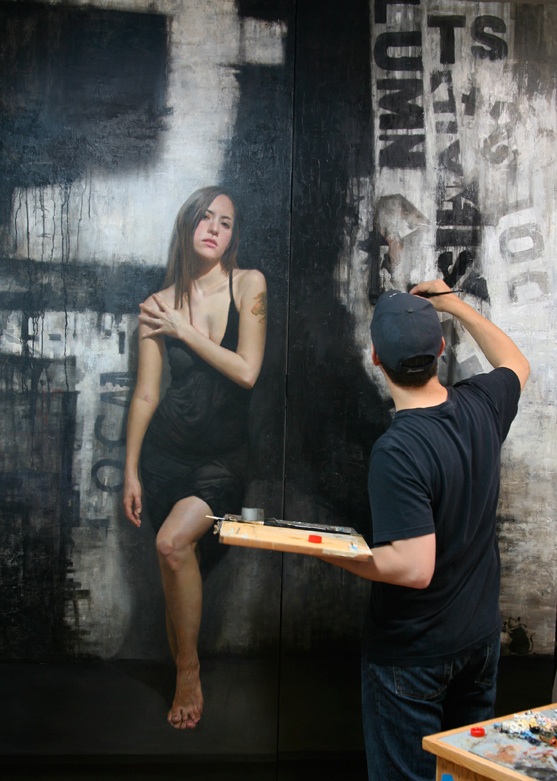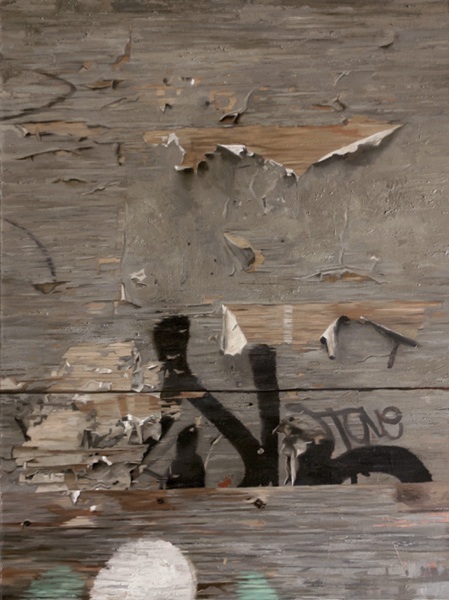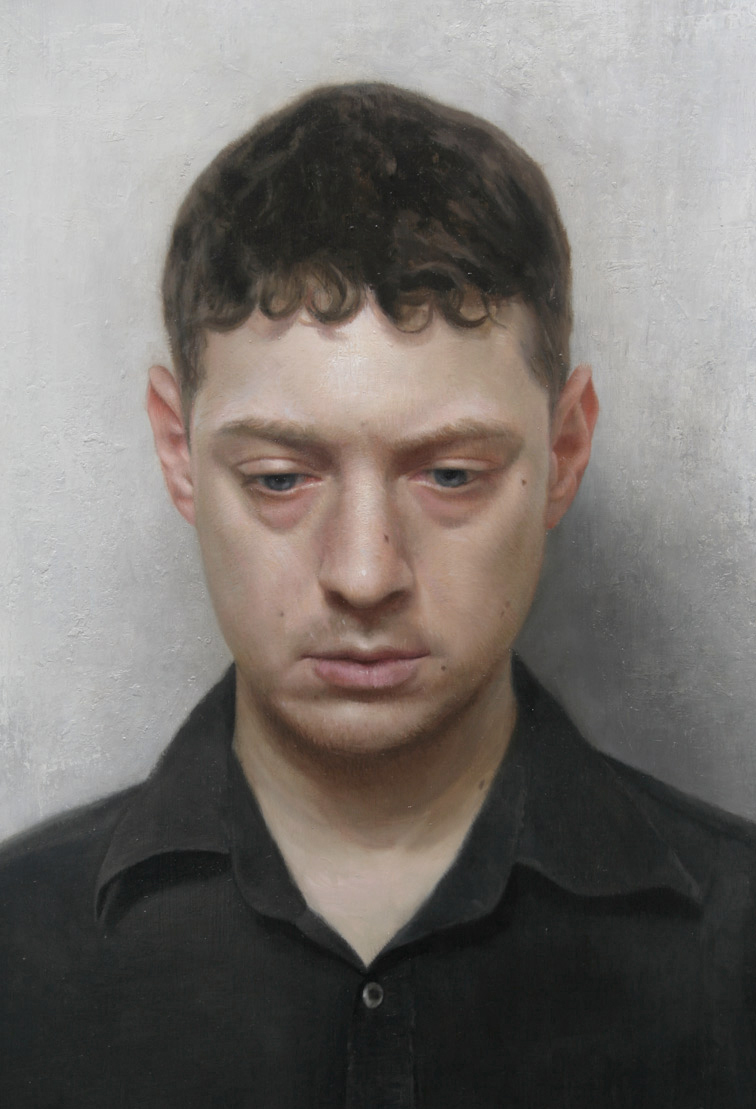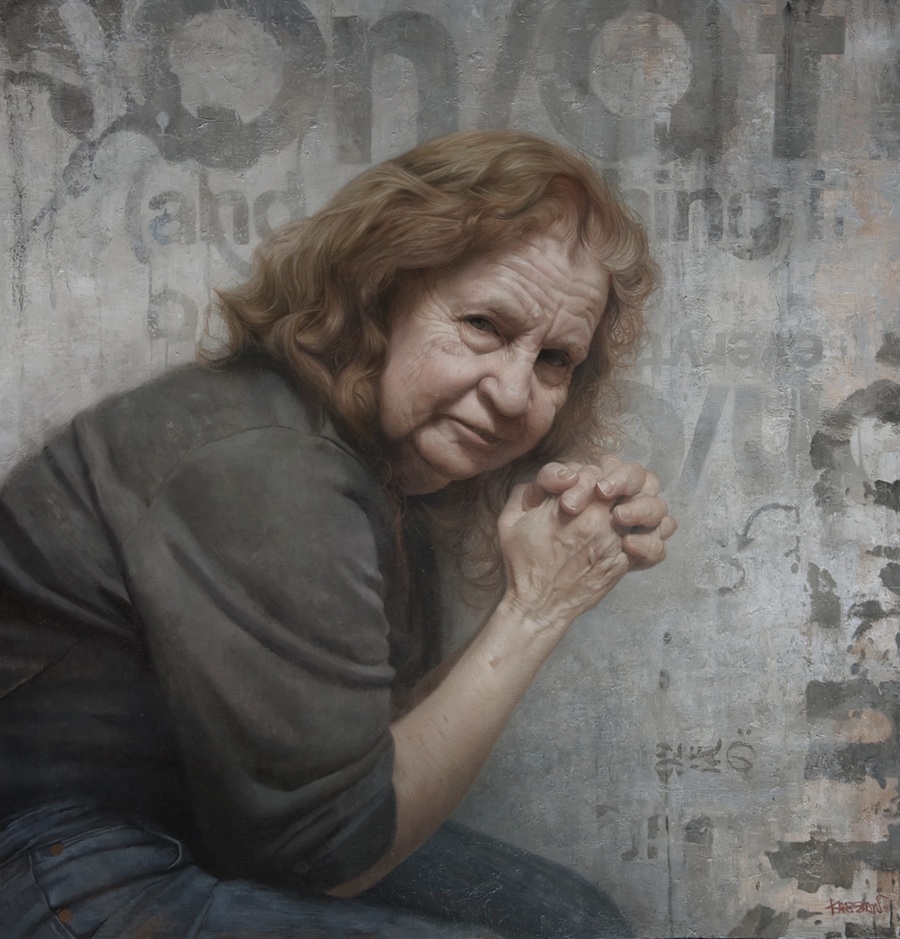
"At work in the studio on Koi," 2008, Image Courtesy of Gallery Henoch, NYC.
In an age of post-abstract representational painting, Brooklyn-based artist David Jon Kassan's stark realism separates him from the pack. With a critical eye for anatomy, he expertly captures the subtle nuances of his subjects' physiognomies through the use of oil on panel, charcoal, and graphite in his life-size paintings and drawings. He recently completed a documentary, Drawing Closer to Life: Documenting an Approach to Drawing, that records his meticulous studio process in action. David is currently working towards his second solo exhibition at Gallery Henoch in September 2011 in Chelsea and is teaching a workshop in the Belgian countryside this July.
Emily Waldorf: You cite the Ashcan School of American Realists as an inspiration. Why realism? What other artists influence you, both contemporary and historical?
David Jon Kassan: Realism is a philosophy as opposed to a style. For me, painting is about observing and recording my existence as accurately as I can, it's my way of understanding the world around me and staying constantly engaged with it, the more carefully and patiently I look at what interests me in the world the more faithfully and honestly I can document it. It is only through intense, subtly nuanced observation that we develop an understanding of the psychology of the subject. I'm hugely influenced by the stark truthfulness of Lucien Freud, Andrew Wyeth, and Antonio Garcia, as well as the psychological aspects of Jerome Witkin and Francis Bacon. I am also inspired by the usual suspects such as Rembrandt, Alma Tadema, Bouguereau, Sargent, and Waterhouse. They made paintings that breathe. I'm also a huge fan of the New York school painters, Rauschenberg, Klein, Jasper Johns, Twombly, to name only a few.
EW: What's your philosophy on the nature of the portrait? What do you think it fulfills within society and what should its purpose be?
DJK: Not sure if I have one. I'm aware of the history of the genre and I rarely do portrait commissions. When I do, they are rarely any good. I tend to paint my subjects exactly how they are and that is not always cool to the sitter, they want to look younger, thinner and with lower hairlines. I sort of feel that the role of a portrait in society is to represent the sitters, we see paintings of Shakespeare and we believe that it is what he looked like, well maybe a little older, fatter and with a higher hairline. I guess it would be cool if the portraits that were painted really did look like the sitter or expressed some sort of emotion that gave the viewers in the future a sense of the sitter's pathos at the time it was painted.

"Peeling Paint," oil on panel, 20 x 16 inches, 2007, Image Courtesy of Gallery Henoch, NYC.
EW: How do you view the concepts of the real, the hyper-real, the authentic and the imagined playing out within your works?
DJK: I want my paintings to give the viewer a true sense of reality - that includes but is not limited to depth, scale and a tactile surface as well as the real sense of what the subject looks like and is feeling at the time that I painted them. There should be a discourse between the viewer and the subject, to feel as though they are in a way connected. My goal is not to set a narrative but rather to have the viewer bring their own experiences to the painting and the subject as they would if they had seen the subject on the street in real life.
EW: Your figures are often set against a more abstract and somber background. Is this juxtaposition intentional? How do you create the background?
DJK: The backgrounds in my works are referenced from thousands of photos that I have taken around Manhattan; street art, graffiti, torn advertisements, stains, construction barricades. I'm very interested in the anthropological aspects of the city; there are so many different layers that all come together in these random abstractions. It's easy to see where the Abstract Expressionists gained their inspiration. I usually compile these reference photos into Photoshop collages, looking at them as different formalistic abstractions where rigid typography is part of the composition as well rough accidental shapes caused from ripping or staining. I develop the backgrounds in Photoshop with the drawings of the subjects to compose the pieces, which I'll use as a basis for a final painting.
EW: Do you remember your first interaction with art? When did you decide you wanted to become an artist?
DJK: My first interactions with art were vague daydreams that I grew up trying to figure out. While I was young, around the age of four, my family lived in Germany and my father was a pilot in the Air Force. We were able to travel all over Europe to all of the great museums and churches. These first interactions were very confusing to me as I grew up and would have deja vu moments when I was older from seeing paintings and sculptures in books. When did I decide to be an artist? Hmmm, I don't think that I really ever decided to become one, it's just something that I did, something that came naturally enough to me that it wasn't work to learn more about it or how I could really push myself to get better.

"Self Portrait at 30," oil on panel, 26 x 40 inches, 2007, Image Courtesy of Gallery Henoch, NYC.
EW: You recently completed an instructional DVD and also do a lot of teaching. It seems like teaching drawing and painting is central to your artistic practice. How was your own experience in art school? What kind of formal training did you have?
DJK: Teaching is a huge part of what I do. I love to think about what I do out loud, and the best way to do this is to teach. I usually learn a lot from the students in my workshops, because we work to build the classes around a collaborative environment where everyone is working towards the same goal of learning how to observe and see the subject well, because everyone brings different approaches and experiences with them, the other students and myself learn new methods that we can add into what we do. My own experiences with art school are very varied, I studied theory and art history at Syracuse University, the program there was less drawing from life and technique based. Syracuse was incredibly freeing for my mind because there was no reading and regurgitating like I had gone through in high school, so going from the whole non creative environment to a creative environment was definitely something that really opened my mind. In NYC I wanted to develop my observational skills as well as technique so that I would have a better grasp of how to vocalize and paint my concepts. I decided to go back to school at the Art Students League to study life painting full time and better develop my observational skills and understanding of how to approach a painting of the model. I studied with Sharon Sprung, Harvey Dinerstein and Costa Vavagiakis. These technical classes helped me discover how to paint instead of what to paint. A balance between something that is expertly technical as well as very carefully thought out and conceived is something that is extremely important to me.
EW: Does living and working Brooklyn influence your work at all?
DJK: Brooklyn is a huge influence to my work, both in its community and as an environment. Everything in my work is autobiographical. I want my work to reflect this area. The area is rough and urban, yet is very vivid visually; everything is constantly in a state of flux and change, that's why there is such a vibrant young art scene here.

"Roberta Joy Kassan," oil on panel, 27 x 28 inches, 2009, Image Courtesy of Gallery Henoch, NYC.
EW: What's a typical day in your studio like?
DJK: Hectic. I work on five or six different paintings at a time, as I figure out different concepts I can spread the info throughout all of the pieces. Some days I'm preparing surfaces to paint, other days I'm painting the models, or building up a background or doing studies for new paintings. Most of my work is done outside of the studio wandering around Brooklyn and Manhattan just trying to get a feel for the city.
EW: What are some of your favorite art world hangout spots? Do you go to a lot of openings, museums, galleries, and other artists' studios?
DJK: My ultimate favorite art world hang out is the Metropolitan Museum, especially the drawing room, where you can "order" almost any drawing in their collection and they will bring it out for you to study on an easel. I go to a lot of openings at different galleries each month, usually I'll end up at Marlborough Gallery, the Joshua Liner Gallery or Gallery Henoch. At the end of most gallery nights I'll end up at 151 Rivington with my artist friends. We always go to one another's openings and support each other during the Armory Week or down in Miami. Most of the time I'll end up at the Half King right after the openings, because it's pretty much the only decent bar between Tenth and Eleventh Avenues in Chelsea.